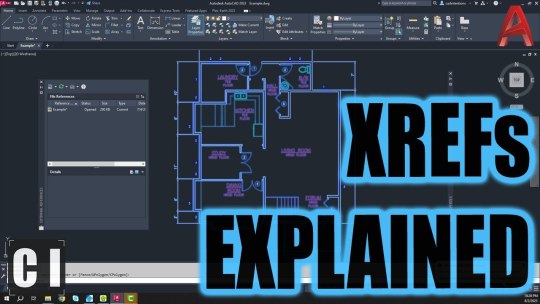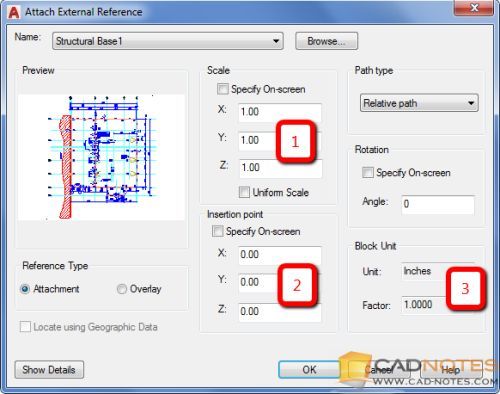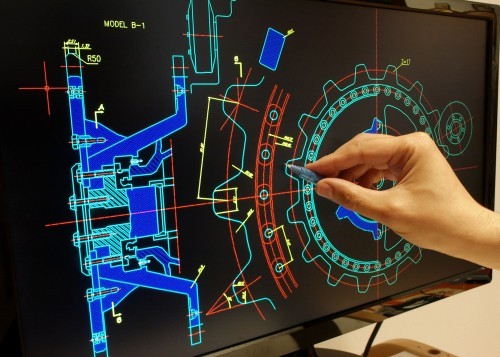#Xref autocad
Explore tagged Tumblr posts
Text
Mastering AutoCAD: A Comprehensive Guide to Advanced Design Challenges

In the dynamic realm of design and drafting, the mastery of AutoCAD stands as a cornerstone skill for individuals aspiring to excel in fields such as engineering, architecture, and design. As students embark on their academic journey toward a Master's degree, they are met with a series of intricate challenges that extend beyond routine tasks, pushing the boundaries of their technical expertise. These challenges not only serve as assessments of their proficiency in AutoCAD but also require a strategic and innovative mindset to navigate complex problem-solving scenarios. This blog aims to delve into the intricacies of five master's degree level questions in AutoCAD, unraveling the layers of complexity inherent in the world of computer-aided design and providing valuable insights for those navigating this educational landscape.
The pursuit of excellence in AutoCAD at the master's degree level demands a holistic understanding of the software's capabilities, creative problem-solving skills, and a willingness to seek assistance when faced with intricate challenges. Help with AutoCAD assignments becomes not just a keyword but a beacon guiding students through the complexities of advanced design tasks, fostering a learning environment where theoretical knowledge meets practical application, ultimately preparing them for success in the ever-evolving field of computer-aided design.
1. Advanced 3D Modeling in AutoCAD
Problem: The challenge begins with designing a complex 3D model incorporating diverse geometric shapes. The solution not only involves creating intricate shapes but also optimizing the model for efficient rendering. This question delves into not just the technical aspects of modeling but also strategic considerations for a seamless design process.
2. Dynamic Blocks and Parametric Design
Problem: Dynamic blocks and parametric design are at the forefront of modern CAD practices. Creating a parametrically controlled dynamic block for a furniture component challenges students to think beyond static designs. The solution involves understanding the dynamic properties, establishing relationships between parameters, and discussing the advantages of dynamic blocks in real-world design workflows.
3. AutoCAD Customization with AutoLISP
Problem: AutoLISP programming is a powerful tool for customization in AutoCAD. Crafting a custom command or routine to streamline a specific design task showcases not only programming skills but also the practical application of customization in a professional setting. The solution includes providing the complete AutoLISP code, explaining its functionality, and discussing its impact on workflow efficiency.
4. Collaborative Design in AutoCAD
Problem: Collaborative design is a crucial aspect of many projects. This question challenges students to create a multi-user environment in AutoCAD, emphasizing features like "Xref," "Sheet Sets," or "CAD Standards" to streamline collaboration. The solution addresses challenges in coordinating design changes, managing references, and ensuring consistency across the project.
5. AutoCAD and BIM Integration
Problem: The integration of AutoCAD into a Building Information Modeling (BIM) workflow is a contemporary challenge. Students are tasked with showcasing the interoperability of AutoCAD with BIM tools and discussing the advantages of this integration. This question highlights the importance of understanding how AutoCAD fits into broader design and construction processes.
Help with AutoCAD Assignments: Navigating the Complexity
Undoubtedly, mastering AutoCAD requires a combination of theoretical knowledge and practical application. As students grapple with these challenging questions, seeking help with AutoCAD assignments becomes crucial. Understanding the nuances of each problem and refining one's skills often involves guidance from experts in the field.
Whether it's elucidating the intricacies of 3D modeling, unraveling the mysteries of AutoLISP programming, or addressing the challenges of collaborative design, a reliable source of assistance can make a significant difference. For those seeking help with AutoCAD assignments, various online platforms and professional tutors offer personalized guidance to ensure a deeper understanding of the subject matter.
In conclusion, tackling master's degree level AutoCAD questions goes beyond routine design tasks. It requires a holistic understanding of the software's capabilities, strategic thinking, and the ability to adapt to modern design practices. As students navigate these challenges, seeking assistance not only enhances their learning experience but also sets the foundation for a successful career in the dynamic world of computer-aided design.
#Autocad Assignment Help#Autocad Assignment Helper#Help with Autocad Assignments#Do My Autocad Assignment#Complete My Autocad Assignment
8 notes
·
View notes
Text
Phat trien ky nang AutoCAD thong qua du an thuc te
1. Bắt đầu với các dự án nhỏ Vẽ bản thiết kế nhà đơn giản: Khởi đầu bằng cách vẽ một sơ đồ sàn nhà đơn giản. Tập trung vào việc sử dụng các lệnh cơ bản như Line, Circle, Trim, Extend, Offset. Thiết kế các đối tượng cơ bản: Hãy thử tạo các đối tượng kỹ thuật như bu-lông, ốc vít, hoặc các chi tiết máy. Điều này giúp bạn nắm vững các lệnh như Fillet, Chamfer, và tạo đường cong. 2. Áp dụng các tính năng nâng cao Sử dụng Layer: Tìm hiểu cách quản lý Layer để có thể kiểm soát tốt các thành phần khác nhau của bản vẽ. Ví dụ, chia các thành phần điện, nước, và kết cấu thành các Layer khác nhau. Blocks và Dynamic Blocks: Học cách sử dụng và tạo Blocks để tái sử dụng các phần tử thường xuyên và các Dynamic Blocks để tạo ra các đối tượng có khả năng thay đổi. Annotative Objects: Học cách sử dụng các Annotative Dimensions và Text để tự động thay đổi kích thước của ghi chú dựa trên tỷ lệ bản vẽ. 3. Thực hiện các dự án thực tế Thiết kế nội thất căn hộ: Thực hiện dự án thiết kế nội thất của một căn hộ, bao gồm cả bố trí không gian, nội thất và điện, nước. Thiết kế công trình xây dựng: Tham gia vào một dự án thiết kế chi tiết kết cấu của một tòa nhà. Dự án này sẽ giúp bạn hiểu rõ hơn về các yêu cầu kỹ thuật và quy chuẩn xây dựng. Dự án hạ tầng kỹ thuật: Thực hiện các bản vẽ về quy hoạch hạ tầng giao thông, cấp thoát nước, hoặc các công trình công cộng. 4. Sử dụng các công cụ bổ trợ Xref (External Reference): Sử dụng Xref để liên kết các bản vẽ với nhau, giúp quản lý dự án lớn một cách hiệu quả hơn. Layouts và Viewports: Học cách sử dụng Layouts và Viewports để tạo các bản vẽ kỹ thuật chi tiết, cũng như chuẩn bị bản in theo tỷ lệ đúng. 5. Tương tác với các dự án đa ngành Cộng tác với các chuyên gia khác: Làm việc với kiến trúc sư, kỹ sư kết cấu, và kỹ sư MEP (Mechanical, Electrical, Plumbing) để hiểu cách AutoCAD được sử dụng trong các ngành nghề khác nhau. Sử dụng phần mềm khác tích hợp với AutoCAD 2024: Học cách sử dụng AutoCAD với các phần mềm bổ trợ như Revit, Civil 3D, hay phần mềm mô hình hóa 3D để mở rộng khả năng và ứng dụng. 6. Đánh giá và học từ phản hồi Nhận phản hồi từ đồng nghiệp: Khi tham gia dự án, hãy lắng nghe và học hỏi từ phản hồi của các đồng nghiệp hoặc người hướng dẫn. Điều này sẽ giúp bạn cải thiện cách thức vẽ và quản lý bản vẽ. Tự đánh giá: Sau khi hoàn thành một dự án, hãy tự đánh giá những gì bạn đã học được, những khó khăn bạn gặp phải, và làm sao để cải thiện kỹ năng trong các dự án tiếp theo. 7. Thực hành liên tục Để thực sự phát triển kỹ năng AutoCAD, bạn cần thực hành thường xuyên và làm việc trên nhiều loại dự án khác nhau. Dành thời gian mỗi ngày để khám phá các công cụ mới, và thử áp dụng chúng vào các bài tập hoặc dự án thực tế.
0 notes
Text
Scope Computers
AutoCAD Training
(Admission Open Come & join Now)
AutoCAD is a comprehensive computer-aided design (CAD) software developed by Autodesk. It is widely used by architects, engineers, drafters, and designers to create precise 2D and 3D drawings. AutoCAD's robust toolset and versatility make it a preferred choice for various design and drafting applications.
### Key Features:
1. **2D Drafting and Drawing:**
- **Drawing Tools:** Lines, arcs, circles, polygons, and more.
- **Annotation:** Text, dimensions, leaders, and tables for detailing designs.
- **Layers and Blocks:** Organize and reuse drawing components.
2. **3D Modeling:**
- **Solid, Surface, and Mesh Modeling:** Create and edit 3D models.
- **Visualization Tools:** Realistic rendering and shading.
3. **Customization and Automation:**
- **LISP, VBA, and AutoLISP:** Automate repetitive tasks and customize workflows.
- **APIs:** Access to .NET, ObjectARX, and JavaScript for advanced customizations.
4. **Collaboration and Sharing:**
- **DWG File Format:** Industry-standard format for drawings.
- **Xrefs and External References:** Manage complex projects with multiple files.
- **Cloud Integration:** Share and collaborate on designs through Autodesk’s cloud services.
5. **Precision and Accuracy:**
- **Snap and Grid Tools:** Ensure exact placement of elements.
- **Coordinate System:** Use Cartesian and polar coordinates for precision.
6. **Interoperability:**
- **Import/Export Options:** Compatibility with various file formats like DXF, DWF, PDF, and more.
- **Integration with Other Autodesk Products:** Seamless workflow with Revit, Inventor, and other software.
7. **User Interface:**
- **Customizable Workspaces:** Tailor the interface to suit specific tasks or personal preferences.
- **Command Line and Ribbon Interface:** Quick access to tools and commands.
### Applications:
- **Architecture:** Create detailed floor plans, elevations, and sections.
- **Engineering:** Design mechanical parts, electrical schematics, and civil infrastructure.
- **Construction:** Generate construction documents and site plans.
- **Manufacturing:** Draft components and assemblies for production.
AutoCAD remains a powerful tool in various industries due to its precision, versatility, and ability to handle complex designs. Its continuous updates and improvements ensure it meets the evolving needs of design professionals.

#AutoCAD#CAD#AutoCADTraining#CADDesign#CADSoftware#DesignEngineering#CADDrafting#AutoCADCourse#EngineeringDesign#3DModeling#2DDrafting#AutoCADTutorial#AutoCADLearning#ArchitecturalDesign#AutoCADSkills#CADCourse#TechnicalDrawing#AutoCADClasses#AutoCADTips#AutoCADExperts#CADTraining#Engineering#Architecture#Drafting#CADDrawing#AutoCADWorkshop#DesignCourse#Autodesk#AutoCADCertification#MechanicalDesign
0 notes
Text
Unlocking the Potential: AutoCAD Drawing Opening in Different Windows
Introduction
In the realm of computer-aided design (CAD), AutoCAD stands tall as a versatile and indispensable tool. One of its lesser-known yet highly impactful features is the ability to open drawings in different windows. In this article, we'll dive deep into this capability, revealing how it can revolutionize your CAD workflow. Whether you're a seasoned pro or just starting with AutoCAD, this guide is your key to unlocking its potential.

1. Benefits of Opening Drawings in Different Windows
AutoCAD's multi-window feature is a game-changer, offering several advantages:
Improved Productivity: Opening multiple drawings simultaneously streamlines your work, enhancing your efficiency.
Better Organization: Keep related drawings together and easily switch between them for smoother project management.
Enhanced Collaboration: Collaborate seamlessly by comparing, copying, and referencing between different drawings.
Reduced Errors: Minimize the risk of unintended changes by working on separate windows.
2. Getting Started with Multi-Window Mode
Now, let's explore how to utilize this feature effectively:
Accessing Multi-Window Mode: To start, launch AutoCAD and open a drawing. Then, go to the "View" tab and select "New Window."
Navigating Between Windows: Learn the keyboard shortcuts to switch between open windows swiftly.
Managing Multiple Files: Discover tips for managing multiple drawings efficiently.
3. Customizing Your Workspace
Tailor your AutoCAD experience with these steps:
Arranging Windows: Learn how to position and size multiple windows for your convenience.
Customizing Toolbars: Adapt your toolbars and panels to suit your multi-window workflow.
Saving Window Layouts: Save your preferred window arrangements for quick access in future projects.

4. Leveraging LSI Keywords
While discussing these topics, we'll also integrate LSI keywords naturally into the content to enhance SEO without disrupting readability.
5. Challenges and Solutions
Despite its advantages, working with multiple windows can present challenges. We'll address common issues and provide practical solutions:
Performance Optimization: Tips to ensure smooth operation even with multiple windows.
File Compatibility: Handling drawings with different versions and formats.
Resource Management: Efficiently manage system resources to prevent crashes.
6. Exploring Advanced Features
Beyond the basics, AutoCAD offers advanced features that take multi-window drawing to the next level:
Sheet Set Manager: Efficiently manage multiple sheets and layouts in separate windows.
Viewports: Create and manipulate viewports in different windows for enhanced project visualization.
External References (Xrefs): Learn how to use Xrefs across multiple drawings while working in separate windows.
Layer Management: Effectively manage layers and properties across multiple drawings simultaneously.
7. Integrating AutoCAD with Other Software
AutoCAD's versatility extends to integration with other software tools:
AutoCAD and Microsoft Office: Discover how to embed AutoCAD drawings into Word, Excel, or PowerPoint for presentations and documentation.
AutoCAD and 3D Software: Explore how AutoCAD plays well with 3D modeling software, facilitating seamless transitions between 2D and 3D designs.
AutoCAD and PDF Editing Tools: Learn how to edit PDFs created from AutoCAD drawings in external PDF editing software while keeping drawings open in AutoCAD.
8. Expert Tips and Tricks
Unlock the potential of multi-window drawing with these expert tips:
Dual Monitors: Consider using dual monitors for an even more efficient workspace.
AutoCAD Workspaces: Create custom workspaces tailored to your multi-window needs.
Scripting and Macros: Automate repetitive tasks across multiple drawings with scripts and macros.
External Scripts: Integrate external scripts and programming languages for extended functionality.

9. Boosting Efficiency with Plugins and Add-ons
Enhance your AutoCAD experience with third-party plugins and add-ons designed to streamline multi-window drawing. Explore options for optimizing your workflow further.
10. FAQs (Frequently Asked Questions)
How can I open multiple drawings in AutoCAD?
To open multiple drawings, simply follow these steps:
Launch AutoCAD.
Open an existing drawing.
Go to the "View" tab.
Select "New Window."
Can I work on different drawings simultaneously in AutoCAD?
Absolutely! AutoCAD's multi-window mode allows you to work on multiple drawings at once, improving productivity and organization.
Is multi-window mode available in all AutoCAD versions?
Yes, multi-window mode is a standard feature in most AutoCAD versions, ensuring compatibility for a wide range of users.
Can I customize my multi-window workspace?
Certainly. You can arrange, size, and customize your windows to create the ideal workspace that suits your needs.
How do I switch between open windows in AutoCAD?
You can switch between open windows using keyboard shortcuts like Ctrl+Tab or Ctrl+F6, making navigation a breeze.
What are the benefits of opening drawings in different windows?
Opening drawings in different windows enhance productivity, organization, collaboration, and error reduction in your CAD projects.
Conclusion
In conclusion, mastering AutoCAD's multi-window feature can be a game-changer in your CAD journey. This article has equipped you with the knowledge to leverage this feature effectively, boosting your productivity and organization. So, why wait? Dive into the world of AutoCAD drawing opening in different windows and experience a smoother, more efficient workflow.
0 notes
Text
Starting a project using AutoCAD MEP
New template يوفر لنا برنامج أوتوديسك أوتوكاد ميب قوالب جاهزة لبدء المشروع الخاص بنا وهي مصنفة مجموعات اما على حسب العمل طباعة او تصميم او على حسب نظام القياس STUDY THIS COURSE Contact Constructor Attach DWG لبدء تصميم الانظمة بالمبنى يتم ربطه اولا بالمشروع الجديد الخاص بنا وذلك من خلال طريقتان اما عن طريق Project Navigator او اضافة المبنى كمصدر مرجعي XREF ويتم الوصول لاداة الطريقة…

View On WordPress
0 notes
Text
AutoCAD XREFs Explained! External Reference Tutorial & Must-Know Tips
To start today, I want to thank everyone who joined and has been participating in the CAD Support Community/Forum! we had some new members join over the last few days and I couldn’t be more excited for the group to grow and answer all of your CAD related questions! It’s been awesome to meet everyone and looking forward to meeting/welcoming more of you in the coming weeks/months. If you haven’t…

View On WordPress
0 notes
Text
Mastering AutoCAD: Unleashing Creativity in Design and Exploring Job Opportunities

AutoCAD is a leading computer-aided design (CAD) software that has revolutionized the design industry. From architectural drawings to mechanical designs, AutoCAD offers powerful tools to create precise and detailed 2D and 3D designs. Mastering AutoCAD not only enhances your design skills but also opens up a world of exciting job opportunities. In this comprehensive guide, we will explore the realm of AutoCAD, provide you with essential tips and techniques, and delve into the diverse job opportunities available for AutoCAD professionals.
Understanding AutoCAD:
AutoCAD is a software application used by architects, engineers, and designers to create precise and accurate technical drawings. It allows users to create and modify 2D and 3D designs, generate detailed measurements, and annotate drawings with text and dimensions. AutoCAD provides a wide range of tools and functionalities to support various design disciplines.
Creating 2D Drawings:
AutoCAD excels at creating detailed 2D drawings, such as floor plans, elevations, and sections. Learn how to use drawing tools, layers, and linetypes to create precise geometry. Master the use of dimensions, text, and hatch patterns to annotate your drawings and convey essential information.
Working in 3D:
AutoCAD's 3D capabilities enable users to create complex 3D models and visualizations. Explore techniques to create 3D geometry, apply materials and textures, and render realistic images. Learn about lighting, shading, and camera settings to enhance the visual appeal of your 3D designs.
Customization and Automation:
AutoCAD offers customization options to streamline your workflow and automate repetitive tasks. Discover how to create custom tool palettes, modify menus and shortcuts, and develop scripts using AutoLISP or Visual Basic for Applications (VBA). Harnessing these customization and automation capabilities can significantly boost your productivity.
Collaboration and File Management:
Collaboration is essential in design projects, and AutoCAD provides tools to facilitate collaboration and file management. Learn how to use Xrefs (external references) to link drawings and coordinate with team members. Explore features like Autodesk A360 and AutoCAD's file formats for efficient sharing and version control.
Job Opportunities for AutoCAD Professionals:
Proficiency in AutoCAD opens up numerous job opportunities across industries. Here are some roles to consider:
Architectural Drafter: Architectural drafters use AutoCAD to create detailed architectural drawings, including floor plans, sections, and elevations.
Civil Engineer: Civil engineers utilize AutoCAD for infrastructure design, such as road layouts, site plans, and drainage systems.
Mechanical Designer: Mechanical designers use AutoCAD to create precise technical drawings for mechanical components and systems.
Structural Drafter: Structural drafters use AutoCAD to create detailed drawings of structural elements in buildings and infrastructure projects.
CAD Technician: CAD technicians provide support in various design disciplines, assisting with drawing production, file management, and design documentation.
Conclusion:
Mastering AutoCAD empowers you to unleash your creativity in design and opens doors to diverse job opportunities. By understanding the tools and techniques in AutoCAD, you can create precise and detailed 2D and 3D designs, collaborate effectively, and enhance your design skills. The job opportunities in architecture, engineering, and design industries are abundant for AutoCAD professionals. Embrace the power of AutoCAD, unlock your design potential, and embark on a rewarding career where your AutoCAD expertise is highly valued.
0 notes
Text
Highway Drawings Autocad
“Highway Drawings with CAD” course covers details process of drawing creation considering highways features as the prerequisite. Preparation of highway drawings, needs to use various xrefs such as highway xref, road marking xref, pavement xrefs, etc. The course provides a comprehensive process to create highway drawing from scratch to printing final PDFs.
The first module provides the operation process of the X-ref manager. It provides all the details of subcommands within xref window and how to operate it. It also demonstrates the process to create an xref and how to attach it with other drawings.
The second module provides an operation process of drawings sheet production. It covers the process to set the drawing layouts with xrefs and then provides the details of sheet layout setting along with printer setting. Lastly, it covers the printing PDF process to generate hard copy drawings.
The third module runs a pilot to generate pavement drawings. it covers step by step process to create pavement xref, layer creation of each pavement types, sheet layout setting, title frame setting, legend, notes, scale setting and finally printing drawings as PDF process. For more info, please visit: Highway Drawings Autocad
0 notes
Text
Xref autocad

When you open your drawing, each referenced drawing is automatically reloaded, so it reflects the latest state of the referenced drawing file. With xrefs you can build drawings without significantly increasing the drawing file size.īy using referenced drawings in AutoCAD Architecture, you can:Ĭoordinate your work with the work of others by referencing other drawings in your drawing to keep up with the changes being made by other designers.Įnsure that the most recent version of the referenced drawing is displayed. Any changes to a referenced drawing are displayed in the current drawing when it is opened or reloaded. Attached xrefs are linked to, but not actually inserted in, another drawing. With xrefs, changes made in the referenced drawing are reflected in the current drawing. You can attach an entire drawing file to the current drawing as a referenced drawing (xref). Updating also occurs when you first open a drawing that contains file references. Reload All References updates all file references to ensure that the most current version is used. Refresh/Reload All References Button – The Refresh button synchronizes the status data of referenced drawing files with the data in memory. The following options are displayed:Īttach (file type) Button - The Attach button displays a list of file types that you can attach (see Figure 2).

You can use the buttons at the top of the External References palette to choose the types of files to attach to the drawing and to refresh the status of file references that you already have attached. The palette will then hide automatically when you move the cursor away from the palette. It is important to note that when using the External References palette, it is recommended that you turn on the Auto-hide feature or anchor the palette. The lower pane, called the Details/Preview Pane, can display properties for the selected file references or it can display a thumbnail preview of the selected file reference. Shortcut menus and function keys provide options for working with the files. The upper pane, called the File References Pane, can display file references in a list or in a tree structure. The External References palette contains several buttons and is split into two panes (see Figure 1). These files can be opened directly from the External References palette. The External References palette in AutoCAD Architecture organizes, displays, and manages referenced files such as DWG files (xrefs), DWF, DWFx, PDF, and raster images. Working with relative xref paths makes moving the project and transmitting it easier and reduces the need to repath the project. In the project setup, you can decide whether to use full paths or relative paths. If you want to use existing non-project files in a project, convert them to project files first.ĭrawing Management supports the use of relative paths for external references. Use the Project Navigator to create, modify and reference project files within the project. Keep these considerations in mind when working with a project:ĭo not delete any XML files generated by the Drawing Management feature. If you reference a non-project file into a project file by mistake, you cannot use the full Drawing Management functionality on that file.

The AutoCAD Architecture Xref Manager cannot differentiate between project drawings and non-project drawings. If you are working in a project environment, the best practice for referencing project drawings into other project drawings is to use the Project Navigator rather than the standard AutoCAD Architecture Xref Manager. For example, a construct that is placed on a specific level will use that level's elevation data to control the Z-axis insertion point when being xrefed into a view. Xrefs that have been created in drawing management can automatically make use of project data, while those that are created manually through the xref palette or command line cannot. However, the background methods employed have additional features. The mechanism of referencing is identical to the regular AutoCAD External References Management feature. This means that elements are referenced into constructs, constructs are referenced into views, and views are referenced into sheets. The Drawing Management feature in AutoCAD® Architecture 2013 uses external references (xrefs) as a means to create a project and maintain it. Back February 1st, 2013 All About External References

0 notes
Text
Word to the wise (because I was about to strangle CAD because I forgot this):
If you are going to xRef a drawing that contains within it ANOTHER xRef BIND THE SUB-XREF. I don’t know how it behaves in newer versions because we’re using a dinosaur version of CAD in our office, but if you xRef a drawing, any xRefs within that file won’t show up when you further xRef it. Which means you could be missing a ton of the drawing.
I figured this out weeks ago, but forgot it, and just spent over an hour trying to get this stupid drawing to properly xRef before I remembered this.
#architecture student#architecture studyblr#architecture#AutoCAD#xRef#xref inside an xref inside an xref#bonus unofficial archie survival tip#learn from my stupidity please#micky rambles#archie problems
6 notes
·
View notes
Text
Tạo và sử dụng block trong AutoCAD 2018
AutoCAD 2018 là một trong những phần mềm thiết kế đồ họa phổ biến nhất trên thế giới. Với các tính năng cải tiến và nâng cấp, AutoCAD 2018 giúp người dùng tạo ra những bản vẽ chất lượng cao và nhanh chóng hơn.
Điểm thu hút của AutoCAD 2018 là khả năng thích ứng với nhu cầu thiết kế của người dùng, từ sản xuất và xây dựng cho đến kỹ thuật, kiến trúc và đồ họa. Nó cung cấp các công cụ đặc biệt để giúp tăng hiệu quả trong quá trình thiết kế bao gồm các công cụ tạo hình, sắp xếp và tối ưu hóa mẫu.
AutoCAD 2018 cũng cung cấp cho người dùng một giao diện dễ sử dụng và linh hoạt với nhiều tính năng tùy chỉnh. Nó cũng hỗ trợ nhiều định dạng file, giúp người dùng dễ dàng chia sẻ và đồng bộ dữ liệu giữa các thiết bị khác nhau.
Tóm lại, autocad 2018 là một công cụ đắc lực cho người dùng trong việc thiết kế và sản xuất AutoCAD 2018 là phiên bản đang được sử dụng phổ biến trong lĩnh vực thiết kế và CAD. Với nhiều tính năng mới và cải tiến, AutoCAD 2018 giúp người dùng tối ưu hóa quy trình làm việc và tăng năng suất.
Điểm mới của phiên bản này bao gồm công cụ Xref chuyên nghiệp, tính năng đặt hàng loạt, màn hình Retina cho người dùng Macbook, công cụ cải thiện chất lượng đường vẽ và khả năng tùy chỉnh màu nền.
AutoCAD 2018 sử dụng ngôn ngữ lập trình AutoLISP, cho phép người dùng tùy chỉnh và mở rộng các chức năng của phần mềm.
0 notes
Text
0 notes
Video
youtube
autocad 2021 Xref compare تاكد انك مشترك في القناة 💯 ومفعل الجرس عشان يوصلك كل جديد 🔔 وما تنساش تعمل لايك للفيديو 👍 شير مشاركة #BIMarabia اشترك في القناة لمتابعة الشروحات الجديدة videos https://www.youtube.com/channel/UCZYaOLTtPmOQX1fgtDFW52Q?sub_confirmation=1 بيم ارابيا https://bit.ly/1TSqEbr Places to find me! https://bit.ly/OcqQ6x https://bit.ly/2nqASDv Wordpress: https://bit.ly/SsszPw Instagram: https://bit.ly/2JY3wZP Twitter: https://twitter.com/omarselm April 10, 2020 at 09:07AM by BIMarabia
0 notes
Text
5 Of The Ideal Alternatives to AutoCAD

AutoCAD can be a flagship solution by Autodesk, the drafting market's juggernaut, designed to assist its customers with product or building design, manufacturing planning, structure and civil rights.
The sleek, three dimensional, computer-aided design software is fully-featured but prices far more than just other programs which fit its own capabilities. Because 1982, if it had been offered, AutoCAD's large selection of flexibility and features for use in several businesses ensure it is that the most goto product for most both students, professionals, and hobbyists alike.
But, Autodesk no-longer supplies endless licensing for CAD programs and converted into your centric certification instead, which forces people to seek out options. From the future it can be costlier to make the swap, although for CAD experts that aren't limited budget-wise, paying more than £ 1200 might appear worthwhile.
If you are the typical pupil or hobbyist doing work to get a budget, you really do not need to at all times choose AutoCAD. You can find a number of deserving contenders with very comparable encouraging infrastructure and also critical operation. The process is in selecting which AutoCAD options are worth your own time and effort, since the current marketplace is awash with gruesome knockoffs. Our five AutoCAD alternatives are not only inexpensive but see very related documents to all those AutoCAD reads, but easily integrate with AutoCAD alternative, and are instinctive to know.
5 of the Best HVAC CAD
SolidWorks
For a little while, CAD software has received pretty very great support for 3D modelling, however, its best strengths continue being as being a 2D-design and deploying architectural software. Solidworks, as its name suggests, can be actually a parametric solid modeller concentrated mainly around 3D designs. This usually means that you'll have to own any knowledge of engineering terms instead of just geometric ones.
youtube
The latest variant of SolidWorks has excellent features like the capability to do free hand sketches on touch screens. Despite being chiefly concentrated on 3D Growing, its 2 d sketching tool still remains functional, though it's much milder than that which you find in AutoCAD.
BricsCAD
This CAD system is popularly famous for its advantage capabilities and has several recognizable features for example native.dwg applications. If you should be familiar with AutoCAD's 2008 variant, BricsCAD has a marginally similar interface also loaded characteristics in second design and 3D direct modeling. You can utilize it with the significant systems such as macOS, Windows, and Linux, and countless of thirdparty apps from throughout the Earth, which are located on.dwg.
Being paid software like AutoCAD, BricsCAD is significantly more cheap using three editions: Classic, Pro, and Platinum. The latter is feature-packed with programs that aren't utilized in AutoCAD such as for example Sheet metal, 3D Evaluate, and BIM. BricsCAD additionally integrates with cloud, which includes a robust rendering engine, recognizes XREFS, and can be now also user friendly.
DraftSight
Draftsight can be an professional-grade alternative to AutoCAD, designed for people looking for improved means to browse, create, and share.dwg documents. The open 2nd CAD software isn't difficult to use and is dependant on advanced design including all of the tools which you should generate technical 2D drawings. From professional computer-aided design consumers to teachers and pupils, DraftSight is designed for a completely free download and activation in afew momemts. In addition, it runs on various OS platforms including Windows XP/Vista/7.
SketchUp (No Cost )
Previously Google SketchUp, this totally free tool can be a wonderful pick for CAD professionals. Sketch-up is actually just a 3D-modeling application employed in a wide array of applications from interior design; civil, architectural, and mechanical engineering; video game and film design. Available as a freeware variant, this tool works together several sorts of documents which include DWG, DXF, OBJ, XSI, and much a lot more, and may export HD animations along with PDFs.
LibreCAD (Free)
That is another free alternative program you can use that's feature-rich and commands a large following of customers and designers. LibreCAD is a high-tech opensource 2D-modeling software birthed from QCAD (later known as CADuntu) and looks AutoCAD in concept and also functions.
1 note
·
View note
Photo

Task 1 - AutoCAD
Layers. XRef. Scale. Clip. Dimension. Text. Plot
1 note
·
View note